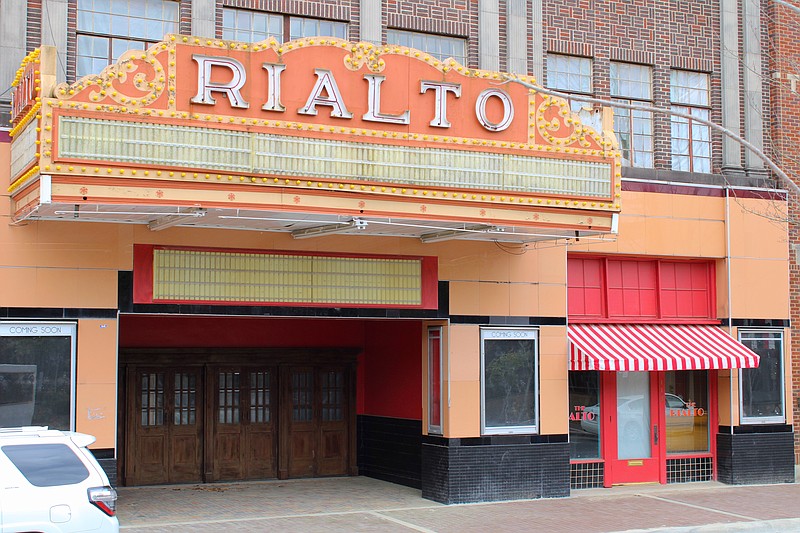EL DORADO -- Renovations to downtown El Dorado's historic Rialto Theatre are still on the itinerary at the Murphy Arts District, according to district CEO Pam Griffin, although considerations -- particularly financial ones -- make the theater's rebirth, at least in the near term, uncertain.
The current version of the Rialto was constructed in 1929, built on the foundation of an older version of the theater built in 1918, according to the Encyclopedia of Arkansas.
It served as a space to entertain El Dorado's post-oil boom population, offering live performances as well as movies.
The building maintains hallmarks of its time, ranging from its Classical Revival architectural aesthetics to a side door and back balcony that Black patrons were forced to use during the Jim Crow segregation era.
The theatre closed from 1980 to 1987 before reopening as a movie theater that ended operations in 2006.
The Murphy Arts District purchased the building in 2012 and folded plans to revitalize and utilize the building in with the overall plans to create the district.
Griffin explained in an interview on Monday how renovations for several district-owned downtown buildings were pushed to "Phase 2" rather than the initial round of district construction.
"There were construction drawings prepared by the architectural firm in 2016, which is when they finalized the architectural drawings for the whole Murphy Arts District. We took all of those drawings out to bid with contractors and they came back with some pretty hefty numbers to build the whole district, which includes what we've already done as well as the Rialto, the McWilliams and the Trinca [Shoe Repair] building," Griffin said.
"We had some hard decisions to make, because we did not have the money to do it all. It came back probably 40% to 50% more than the architects originally told us it would take to build it," she added.
This is when the project was split into Phase 1, which resulted in current arts district venues such as the Amphitheater, the First Financial Music Hall and the Murphy Arts District Playscape, and Phase 2, which includes projects such as the Rialto.
Griffin said that the decision at the time was tough but ultimately, in her view, a good one.
"From an operational standpoint, it's been very beneficial to us as a day-to-day team because the cost and the people it takes to do what we do stretches us. It stretched us opening weekend, it stretched us in our pre-covid days and it still stretches us today... to operate all of it, maintain it, keep it all clean and keep people here to do it all," she said.
Another consideration was and is the need for the arts district to grow its audience to justify the expanded venue capacity.
Currently, architecture firm DLR Group is performing a study at the theater to revamp the arts district's renovation plans.
The renovations would be a balancing act of maintaining the theatre's historical aesthetic and value while modernizing parts of the interior.
The original renovation plans included removing the back wall of the building, expanding the stage "10 or 12 feet" and expanding the back rooms, including green rooms and production rooms.
"We've had all those drawings [and] if we wanted to go to work tomorrow, we have architectural drawings to do it... [But] we've kind of gone back to the drawing board to say if we wanted to have the Rialto what the architects call 'clean, warm, dry and operable' -- to see what that means and how much that costs," Griffin said.
She added that the results from the study are expected to be available by the end of the month.
Costs, particularly post-construction operating costs, would still be the central consideration for moving forward with any potential plans.
"They'll tell us what that means and what that costs and we'll have to make the decision of whether that is something we can afford both for construction and operations moving forward, and what the timeline will be," Griffin said.
Historical preservation would be a central part of renovations, though some outdated amenities -- five toilets in the building for an 800-person capacity building, in one example Griffin gave -- will need modernizing.
Little material from the theatre's history remains currently, though clearing out the building would likely be part of any renovation plan.
"[The building] has basically been gutted. The partition in the balcony that split it into two rooms is gone and it's open again. There is still some old movie projector equipment up there, and there's some posters and movie reels," Griffin said.
"The work that we did to gut it is work that would need to happen anyways. The chairs in there were not original, they were 1980s movie theater seats... It will get new seats and things like that," Griffin said.
Griffin estimated the potential construction process for the building would likely take 18 months.
The concerns that first forced the arts district to split its plans into phases still exist, leaving the future of the Rialto uncertain but hopeful at the moment.
"My main concern, sitting in the chair I sit in every day, is not so much the construction costs but the ongoing operational costs. We've run at a deficit every year here. ... If each event covers its own cost, we're doing good, but you still have all that overhead [payroll, utilities, property taxes and insurance] to pay," Griffin said.
El Dorado Festivals & Events, which operates the Murphy Arts District, is a 501(c)3 nonprofit organization.
"It would add to our need for cash. ... It would be great to get [the Rialto] up and running and operational, but what will we run it with? There's that struggle as well," Griffin said.
